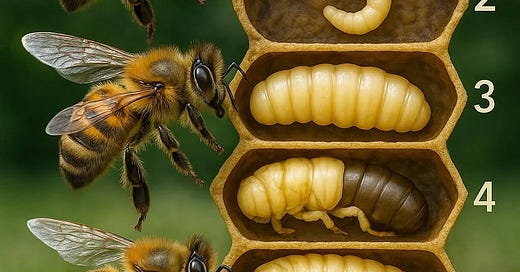Life Cycle of the Bee: A Journey from Egg to Worker Bee
Bees are not just tiny insects that produce honey; they are symbols of cooperation and hard work. Their life cycle is fascinating and begins with a tiny egg that eventually becomes an active bee playing multiple roles to ensure the colony’s survival. Let’s explore each stage of a bee’s life in detail:
---
1. The Egg
It all starts with the egg laid by the queen. The queen is the only one in the colony capable of laying eggs and can lay up to 2,000 eggs a day during peak activity. These tiny eggs are laid in wax hexagonal cells called brood cells. The egg is white and looks like a tiny speck. It takes 3 days to hatch.
Fun Facts:
The queen can control the type of egg she lays: a fertilized one becomes a female bee (worker or queen), while an unfertilized one becomes a drone (male).
Thanks to this control, the queen maintains the balance between males and females in the colony.
---
2. The Larva
After 3 days, the egg hatches into a small white larva. At this stage, the larva cannot move and completely depends on worker bees for nourishment. It is fed "royal jelly," a protein-rich food produced by worker bees, which allows it to grow quickly.
After 3 days of royal jelly, it starts receiving a mixture of nectar and pollen. The larva continues growing for 6 days, increasing in size rapidly—consuming up to its own weight every hour!
Additional Info:
Queen-destined larvae are fed exclusively on royal jelly throughout their development, enabling them to become queens.
Worker bees constantly clean and feed the cells to ensure healthy development.
---
3. The Pupa
Once the larva reaches a certain size, its cell is sealed with wax, and the next stage begins: the pupa. In this stage, complete metamorphosis occurs. The larva transforms into an adult bee. This process takes about 12 days, during which wings, legs, and mouthparts form.
Important Note:
This stage is known as complete me





